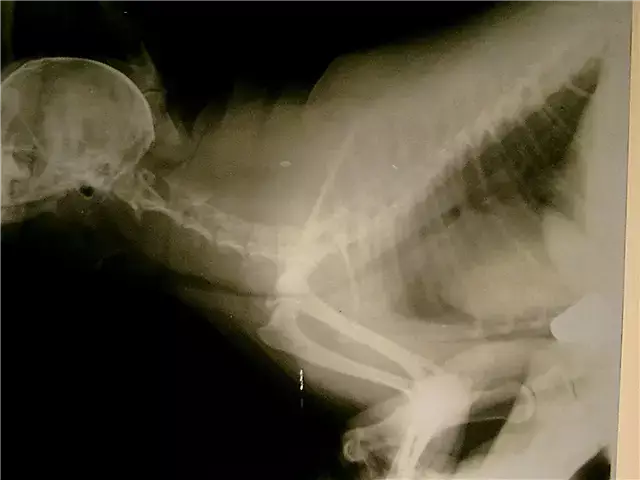- Author Rachel Wainwright [email protected].
- Public 2023-12-15 07:39.
- Last modified 2025-11-02 20:14.
Artifrin
Instructions for use:
- 1. Release form and composition
- 2. Indications for use
- 3. Contraindications
- 4. Method of application and dosage
- 5. Side effects
- 6. Special instructions
- 7. Drug interactions
- 8. Terms and conditions of storage

Artifrin is a topical combination drug used in dentistry for anesthesia.
Release form and composition
Dosage form of Artifrinum release - solution for injection: transparent, yellowish-greenish or colorless (in cartridges or ampoules of 1.7 ml, 10 cartridges / ampoules in a cardboard box; 1.7 or 1.8 ml in cartridges, 10 cartridges in blisters, 1 or 5 packs in a cardboard box).
Active substances in 1 ml of solution (in terms of 100% substance):
- articaine hydrochloride - 40 mg;
- epinephrine (as hydrochloride) 0.006 mg
Auxiliary components: 1M hydrochloric acid solution, sodium metabisulfite, glycine, sodium chloride, water for injection.
Indications for use
Artifrinum is prescribed for infiltration and conduction anesthesia in dentistry, including the following diseases / conditions:
- caries and its complications (treatment);
- preparation of teeth for crowns;
- uncomplicated extraction of one or more teeth.
Contraindications
- cholinesterase deficiency;
- paroxysmal tachycardia and other tachyarrhythmias;
- angle-closure glaucoma;
- decompensated heart failure;
- hypersensitivity to the components of the drug or sulfites (especially in patients with bronchial asthma).
Injection of the solution into inflamed tissues should be avoided.
Artifrine is not intended for use in general surgical practice.
Method of administration and dosage
The dosage regimen of Artifrin is determined individually.
Recommended dosage regimen:
- uncomplicated forceps extraction of upper jaw teeth (in the absence of inflammation): 0.5-1 ml for each tooth; the solution is injected from the vestibular side into the submucosa of the transitional fold. If necessary, to ensure complete anesthesia, it is possible to introduce an additional vestibular injection at a dose of 1-1.7 ml. To create a palatine depot with palatal incisions / sutures, 0.1-0.2 ml per injection is indicated;
- uncomplicated forceps removal of mandibular premolars (in the absence of inflammation): 0.5-1.7 ml per tooth; the solution is injected into the submucosa of the transitional fold. If necessary, it is possible to introduce an additional vestibular injection at a dose of 1-1.7 ml. If the desired effect is not achieved, a mandibular nerve block is performed;
- treatment of carious cavities, preparation for the crown of any tooth (excluding the lower molars): 0.5-1 ml for each tooth by the type of infiltration anesthesia from the vestibular side. The volume of the solution is determined by the volume of intervention.
Maximum doses for one treatment procedure:
- adults: 7 mg / kg;
- children 4-12 years old: 5 mg / kg.
Average doses for children for one treatment procedure (depending on weight):
- 30-40 kg: from 0.5 to 2 ml (maximum - 2 ml);
- 20-30 kg: 0.25 to 1 ml (maximum 1.5 ml).
To exclude the possibility of intravascular administration, a trial aspiration should always be performed before the administration of Artifrin.
Side effects
- cardiovascular system: rarely - tachycardia, increased blood pressure, bradycardia;
- digestive system: vomiting, nausea, diarrhea;
- central and peripheral nervous system: visual impairment, headache, dyspnea, tremor, apnea, muscle twitching; rarely - impaired consciousness, convulsions (violations are dose-dependent);
- organ of vision: rarely - diplopia, blurred vision, transient blindness;
- allergic reactions: rarely - inflammation / edema at the injection site, itching, rhinitis, conjunctivitis, skin rash, angioedema, including edema of the lower / upper lip, tongue, cheeks, glottis with difficulty breathing / swallowing, anaphylactic shock, urticaria;
- others: the development of the ischemic zone (with accidental intravascular injection), sometimes progression to the degree of tissue necrosis is possible.
special instructions
For intravenous administration, Artifrin is not intended.
Extreme caution should be exercised when prescribing the drug to patients with cholinesterase deficiency (due to the risk of prolongation, and in some cases, increased action of Artifrin), with cardiac / respiratory disorders.
If the drug is used for the first time, a skin test must be performed: 0.02 ml intradermally. If, within 15 minutes, severe hyperemia, itching and other phenomena of intolerance develop, it is impossible to use Artifrin.
Since the drug contains epinephrine, it should be used with caution in the presence of cardiovascular and endocrine diseases (heart defects, arterial hypertension, thyrotoxicosis, diabetes mellitus, etc.), as well as during therapy with beta-blockers, tricyclic antidepressants and monoamine oxidase inhibitors …
Partially used ampoules / cartridges cannot be used to treat different patients (in order to eliminate the risk of infection).
The ability to drive vehicles and perform potentially hazardous types of work is determined individually, depending on the reaction to Artifrin.
Drug interactions
With the combined use of Artifrinum with certain drugs / substances, the following effects may develop:
- tricyclic antidepressants, monoamine oxidase inhibitors: increased vasoconstrictor effect of epinephrine;
- non-selective beta-blockers: an increase in the likelihood of developing severe bradycardia and hypertensive crisis.
Terms and conditions of storage
Store in a dark place, out of reach of children, without freezing, at a temperature of 8-25 ° C.
Shelf life is 2 years.
Information about the drug is generalized, provided for informational purposes only and does not replace the official instructions. Self-medication is hazardous to health!






